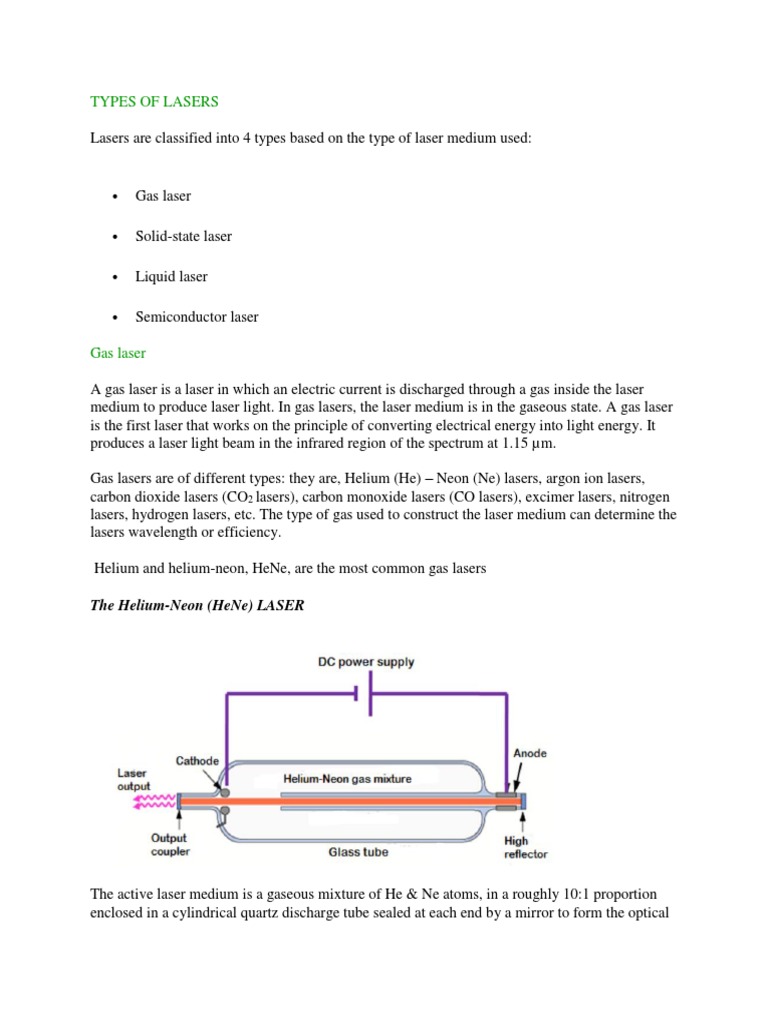In the vast cosmic tapestry of modern technology, lasers emerge as luminous beacons, illuminating a myriad of applications across diverse disciplines. These sophisticated instruments harness the power of concentrated light, embodying both the elegance of fundamental physics and the ingenuity of human innovation. As one traverses the expansive landscape of laser types available in the market, it becomes evident that each variant possesses its own unique charm and utility, akin to the diverse galaxies within the universe.
The laser’s etymology—Light Amplification by Stimulated Emission of Radiation—captures the essence of its operation. At its core, a laser operates by exciting atoms in a medium, leading to the coherent emission of photons. This coherence results in monochromatic light that is spatially and temporally coherent. This discussion delves into the principal categories of lasers available, each uniquely suited for a variety of applications.
1. Solid-State Lasers
At the forefront of laser technology are solid-state lasers, which utilize a solid gain medium, typically composed of a crystalline or glass matrix doped with rare-earth or transition metal ions. These lasers are aptly compared to finely tuned pianos, where each note resonates with precision. They are widely recognized for their robustness, efficiency, and high output power.
Among solid-state lasers, the Nd:YAG (Neodymium-doped Yttrium Aluminum Garnet) laser stands out prominently. With its remarkable ability to produce infrared light at a wavelength of 1064 nm, this laser finds applications in surgical procedures, industrial cutting, and even in tattoo removal. Its versatility can be likened to that of a seasoned musician, adept at playing various musical genres.
Another noteworthy variety is the Ruby laser, one of the first solid-state lasers developed. Emitting red light and characterized by its pulsed operation, it is often utilized in dermatology and aesthetic treatments. The Ruby laser, like vintage wine, offers an unrivaled legacy, harking back to the genesis of laser technology.
2. Gas Lasers
Gas lasers represent another principal category, functioning through the excitation of gas atoms or molecules. They are reminiscent of ethereal symphonies, producing light with finesse and variation. One of the most renowned gas lasers is the Helium-Neon (HeNe) laser, which emits a bright red light at 632.8 nm. This laser is typically employed in barcode scanners, laser pointers, and holography. Its stable output and simplicity make it a staple in scientific and educational settings.
Furthermore, the Carbon Dioxide (CO2) laser operates in the infrared spectrum and is instrumental in industrial laser cutting and engraving. Drawing parallels to a sculptor deftly carving intricate designs from stone, the CO2 laser’s ability to manipulate materials with precision underscores its significance in manufacturing processes.
3. Semiconductor Lasers
Semiconductor lasers, colloquially known as laser diodes, inhabit a domain akin to the vibrant chaos of a bustling marketplace. These compact devices capitalize on the electronic and optical properties of semiconductors to generate laser light. They are prolific in consumer electronics, powering everything from DVD players to fiber optic communications.
Noteworthy for their energy efficiency and small form factor, semiconductor lasers have revolutionized lighting technology through innovations such as solid-state lighting. The amalgamation of brilliance and sustainability positions these lasers as harbingers of a new era in illumination.
4. Fiber Lasers
Fiber lasers epitomize the convergence of laser technology and optical fiber engineering. These devices employ a glass fiber doped with rare-earth elements such as ytterbium or erbium, akin to a finely woven tapestry that transmits light with remarkable fidelity. Fiber lasers are renowned for their high power, beam quality, and efficiency, making them indispensable in metal fabrication, medical therapies, and telecommunications.
The dual nature of fiber lasers invites comparisons to a flowing river. They navigate through various applications, adapting to the environment with grace and resilience, thereby becoming a cornerstone of modern manufacturing processes. Their ability to deliver focused energy with unparalleled precision has redefined the possibilities within laser applications.
5. Dye Lasers
Dye lasers, employing organic dye as the gain medium, introduce a color palette reminiscent of an artist’s canvas. Capable of generating a wide range of wavelengths, from ultraviolet to infrared, these lasers are characterized by their tunability. This tunability allows researchers and practitioners to select specific wavelengths for varied applications, spanning from spectroscopy to laser-based imaging techniques.
Much like a skilled painter blending colors to achieve the desired hue, dye lasers afford scientists the ability to meticulously tailor their output, thus enhancing experimental precision and versatility.
Conclusion
The panorama of laser technology encompasses a remarkable array of types, each distinguished by its unique characteristics and applications. From solid-state and gas lasers to semiconductor, fiber, and dye lasers, their collective contributions resonate across industries, echoing the profound impact of light manipulation on technology and society. As the journey through the realms of laser types unfolds, one is reminded that within the brightness of these tools lies the potential to transform, innovate, and illuminate the future.










